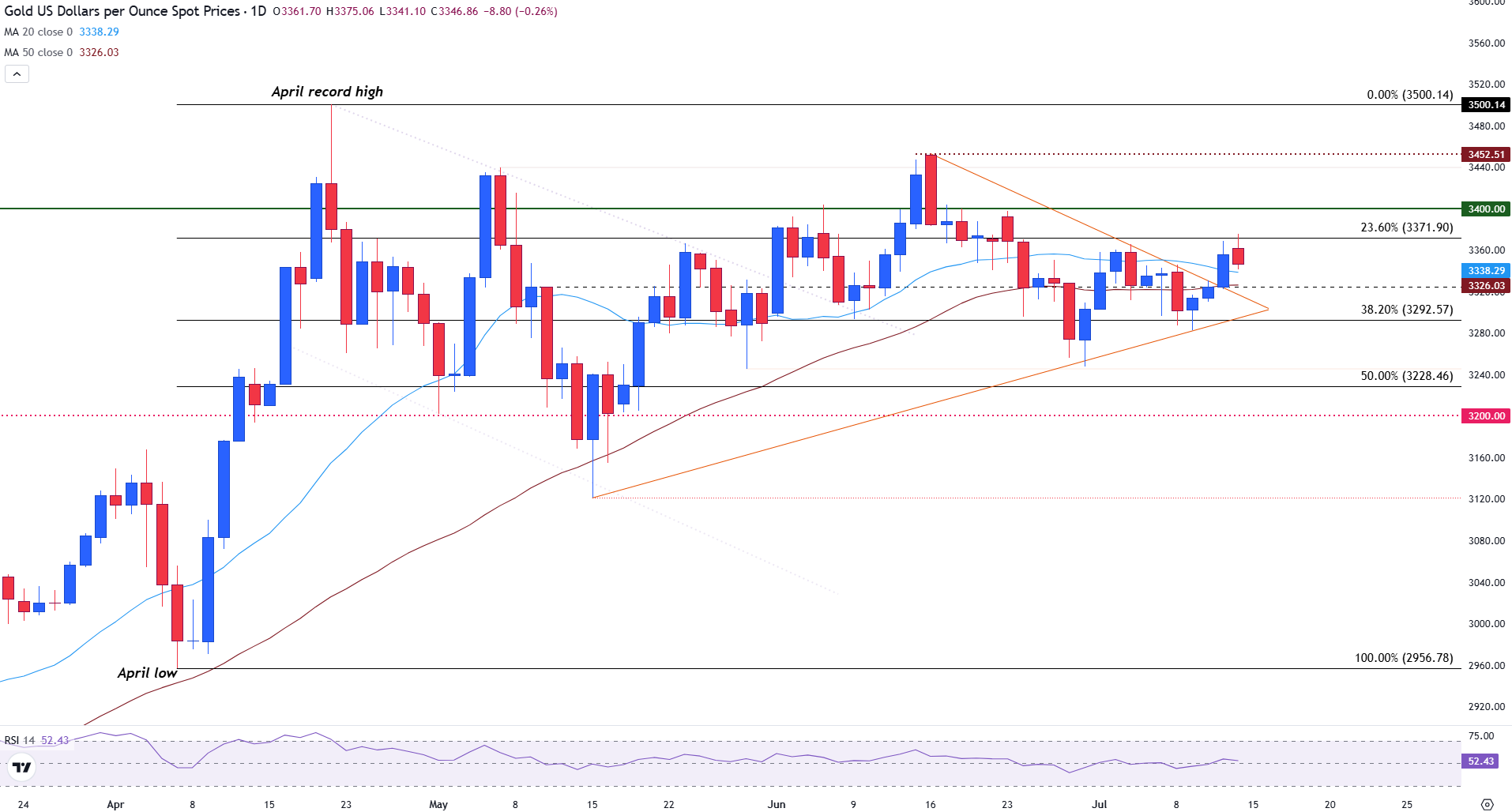
- Gold edges lower as the US Dollar rebounds ahead of Tuesday’s Consumer Price Index (CPI)
- Bullion bulls fail to gain traction above Fibonacci resistance, pushing price action back toward $3,350.
- XAU/USD remains vulnerable to US Dollar price action and risk sentiment.
Gold (XAU/USD) is trading between $3,340 and $3,370 on Monday in response to news that the US may impose a 30% tariff on imports from the European Union (EU) and Mexico, effective August 1.
The latest tariff threats on two of America’s largest trading partners have provided a tailwind for XAU/USD. At the time of writing, the Gold price is trading near $3,350 as bulls struggle to gain the momentum above $3,370.
European Commission President Ursula von der Leyen and Mexican President Claudia Sheinbaum received letters from US President Donald Trump on Saturday. His remarks fueled fears of a new wave of blanket tariffs, boosting demand for Gold as a geopolitical hedge.
A busy day of economic data on Tuesday will likely serve as an additional catalyst for Gold. As policymakers assess the potential implications of the country-specific and sector-specific tariffs, US inflation data will be in focus.
Gold daily digest: XAU/USD reacts to Trump tariffs ahead of key economic data releases
- Reuters reports indicate that 23 countries have received letters from the US President to date. Tariffs of 50% on imports from Brazil remain the highest announced so far.
- Formal letters have also stated that these rates “may be modified, upward or downward, depending on our relationship with your country.”
- President Trump’s Truth Social post also warned the EU against retaliating, quoting that “whatever the number you choose to raise them by … will be added onto the 30%.”
- The EU Commissioner von der Leyen responded on Sunday. An official statement was published on the European Commission’s press corner, which read, “We remain ready to continue working towards an agreement by August 1. At the same time, we will take all necessary steps to safeguard EU interests, including the adoption of proportionate countermeasures if required.”
- Speaking to NBC News on Thursday, Trump also warned of broader action, stating: “We’re just going to say all of the remaining countries are going to pay, whether it’s 20% or 15%. We’ll work that out now.”
- The US will release the Consumer Price Index (CPI) data for June on Tuesday, providing additional insight into whether tariffs are being reflected in prices. With the Federal Reserve (Fed) closely monitoring tariff risks, this report has a direct impact on monetary policy expectations.
- China’s Q2 Gross Domestic Product (GDP), Industrial Production, and Retail Sales for June are also scheduled for release on Tuesday. Any disappointments reflecting a significant slowdown in economic activity will likely continue to underpin the upside momentum for Gold.
Gold technical analysis: XAU/USD breaks triangle resistance, bringing the $3,400 level into focus
Gold has broken out of the triangle pattern on the daily timeframe, suggesting a shift in momentum.
The move above the upper trendline and the 20-day Simple Moving Average (SMA) near $3,340 signals growing bullish pressure.
Current price action remains below the 23.6% Fibonacci retracement of the April low-high move, providing resistance around $3,371, with the intraday high near $3,375.

Gold (XAU/USD) daily chart
If XAU/USD can sustain a close above this zone, the next upside target is the psychological barrier at $3,400.
A clear break of this level could open the door for the June high of $3,452, bringing the April record high near $3,500 back in sight.
On the downside, a move below the 50-day SMA at $3,327 would bring the $3,300 psychological support level back in focus.
With the Relative Strength Index near 56, momentum is trading with a bullish bias. However, there is still room for prices to proceed higher before the market enters overbought territory.
US Dollar FAQs
The US Dollar (USD) is the official currency of the United States of America, and the ‘de facto’ currency of a significant number of other countries where it is found in circulation alongside local notes. It is the most heavily traded currency in the world, accounting for over 88% of all global foreign exchange turnover, or an average of $6.6 trillion in transactions per day, according to data from 2022. Following the second world war, the USD took over from the British Pound as the world’s reserve currency. For most of its history, the US Dollar was backed by Gold, until the Bretton Woods Agreement in 1971 when the Gold Standard went away.
The most important single factor impacting on the value of the US Dollar is monetary policy, which is shaped by the Federal Reserve (Fed). The Fed has two mandates: to achieve price stability (control inflation) and foster full employment. Its primary tool to achieve these two goals is by adjusting interest rates. When prices are rising too quickly and inflation is above the Fed’s 2% target, the Fed will raise rates, which helps the USD value. When inflation falls below 2% or the Unemployment Rate is too high, the Fed may lower interest rates, which weighs on the Greenback.
In extreme situations, the Federal Reserve can also print more Dollars and enact quantitative easing (QE). QE is the process by which the Fed substantially increases the flow of credit in a stuck financial system. It is a non-standard policy measure used when credit has dried up because banks will not lend to each other (out of the fear of counterparty default). It is a last resort when simply lowering interest rates is unlikely to achieve the necessary result. It was the Fed’s weapon of choice to combat the credit crunch that occurred during the Great Financial Crisis in 2008. It involves the Fed printing more Dollars and using them to buy US government bonds predominantly from financial institutions. QE usually leads to a weaker US Dollar.
Quantitative tightening (QT) is the reverse process whereby the Federal Reserve stops buying bonds from financial institutions and does not reinvest the principal from the bonds it holds maturing in new purchases. It is usually positive for the US Dollar.
Information on these pages contains forward-looking statements that involve risks and uncertainties. Markets and instruments profiled on this page are for informational purposes only and should not in any way come across as a recommendation to buy or sell in these assets. You should do your own thorough research before making any investment decisions. FXStreet does not in any way guarantee that this information is free from mistakes, errors, or material misstatements. It also does not guarantee that this information is of a timely nature. Investing in Open Markets involves a great deal of risk, including the loss of all or a portion of your investment, as well as emotional distress. All risks, losses and costs associated with investing, including total loss of principal, are your responsibility. The views and opinions expressed in this article are those of the authors and do not necessarily reflect the official policy or position of FXStreet nor its advertisers. The author will not be held responsible for information that is found at the end of links posted on this page.
If not otherwise explicitly mentioned in the body of the article, at the time of writing, the author has no position in any stock mentioned in this article and no business relationship with any company mentioned. The author has not received compensation for writing this article, other than from FXStreet.
FXStreet and the author do not provide personalized recommendations. The author makes no representations as to the accuracy, completeness, or suitability of this information. FXStreet and the author will not be liable for any errors, omissions or any losses, injuries or damages arising from this information and its display or use. Errors and omissions excepted.
The author and FXStreet are not registered investment advisors and nothing in this article is intended to be investment advice.








